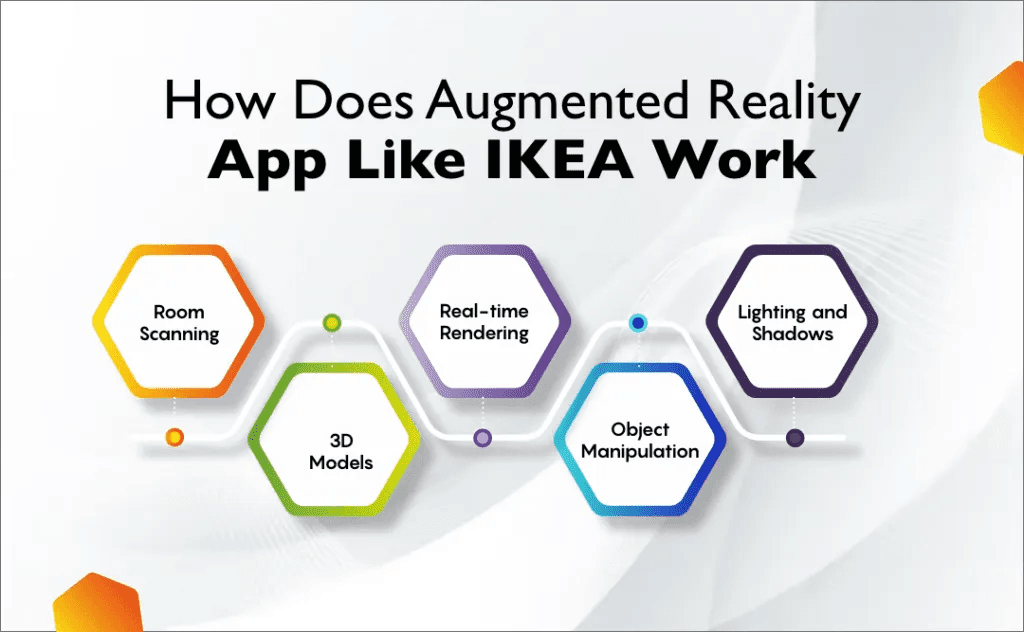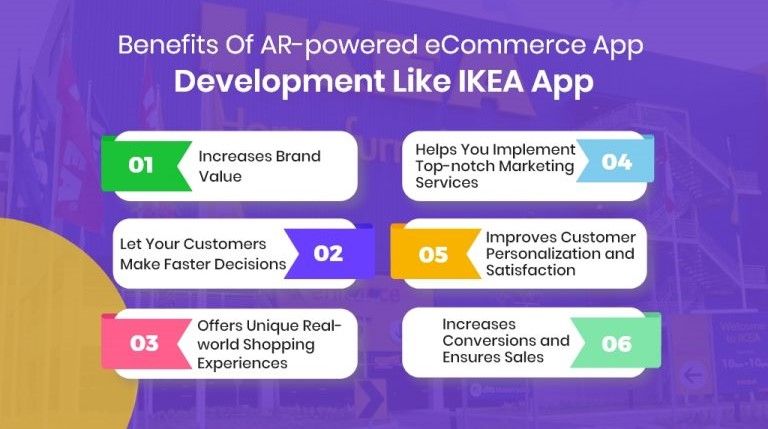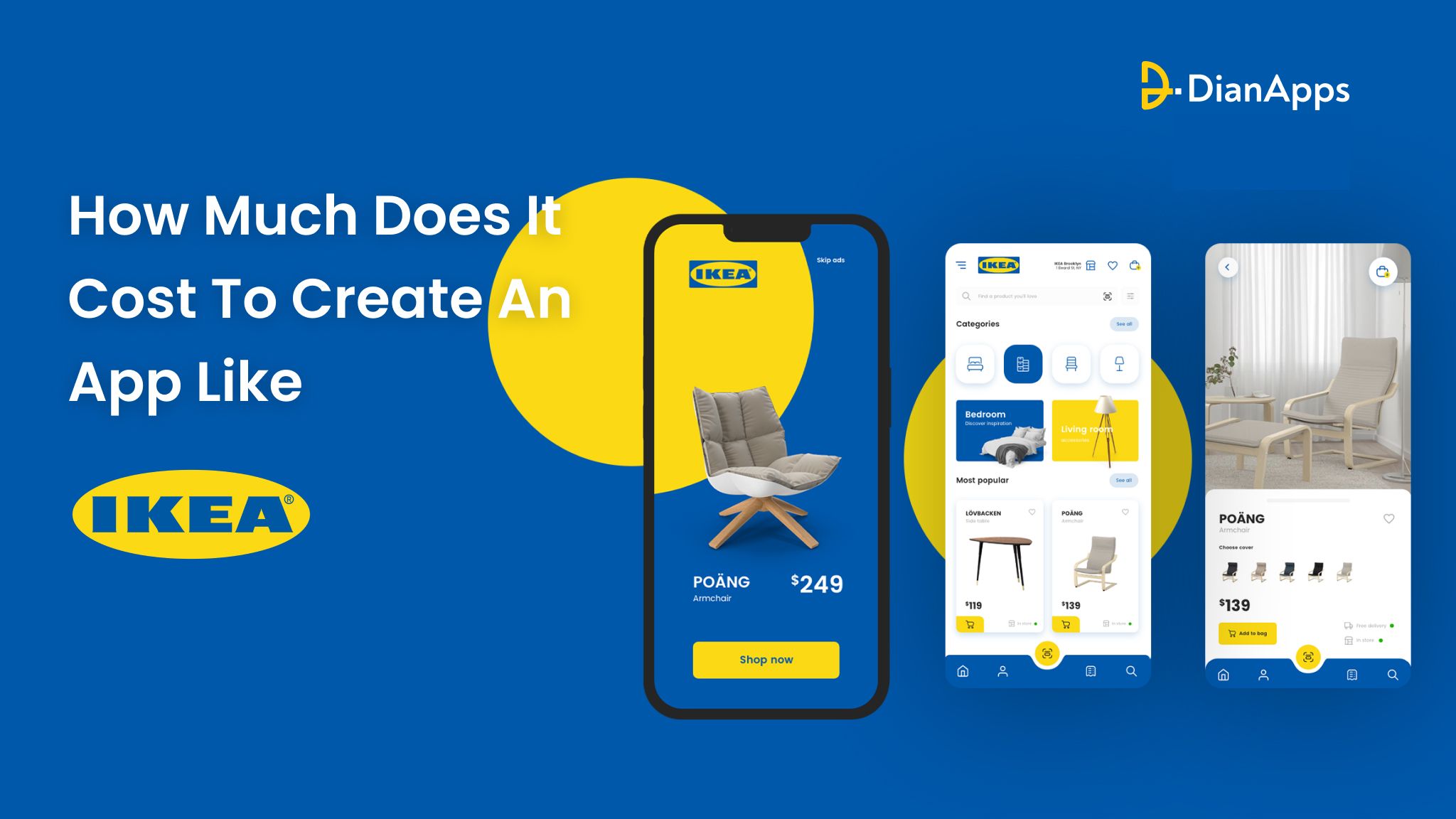Home decor is no longer a trend now, it has evolved into a statement that everyone admires. No matter if it is that couch on the balcony or study table ideal for your bedroom, we all seek to have a neat, uncluttered look to decorate our homes.
However, shopping for furniture has always been a washout in the past as there wasn’t any way to analyze whether design elements would fit in the space or not.
But now, the tables have turned. With evolving technological innovations, shoppers can select, try, and decide to buy anything, right from the comfort of their homes. All this is possible through AR/VR-powered eCommerce apps such as Ikea, Walmart, Wayfair, Amazon, and many more.
With strategic features, the Ikea application makes shopping a lot more easier and comfortable. Here customers have the perks of skipping the long checkout queues by in-store product scanning while walking through the store, saving, and organizing their wishlist items, order tracking, receiving delivery receipts, and home delivery services, simplifying the entire shopping process.
Likewise, Ikea’s innovative approach takes shopping to new heights, where house buyers can try visualizing how a piece of Ikea furniture will look in their space by using Augmented Reality Art. The virtual design design tool lets buyers erase their old furniture and try new ones with Ikea furniture.
Isn’t it an attractive way to draw in more customers and boost retention and conversion rates? Well, it is for sure. You can also build an eCommerce app like Ikea for your business and turn it into a multi-millionaire reality.
Building an eCommerce app like Ikea Place involves careful consideration of various factors, with cost being a primary concern. Let’s explore the financial aspects of developing an app similar to Ikea.
What is IKEA and How does it work?
Currently, Ikea offers three digital platforms to enhance the customer experience. The Ikea Place app utilizes Augmented Reality technology, enabling users worldwide to explore over 2200 furniture items in their catalog. Users can visualize these items in their own spaces before making a purchase, thanks to the app’s 3D rendering capabilities and room-scanning feature. This functionality is particularly beneficial for individuals who are selective about their furniture choices and want to ensure items fit seamlessly into their environment.

Additionally, Ikea provides an online platform where customers can track their orders and arrange for convenient pickup. Lastly, the Ikea catalog offers a comprehensive range of products, serving as a digital resource for browsing their extensive inventory. These digital solutions collectively contribute to a seamless and immersive shopping experience for Ikea customers.
Features of the Ikea App:
- 3D & 360º degree view of the products
- Social media sharing
- Elegant angle positioning
- References to every product page
- A Detailed explanation of every product
- Smooth navigation through various product classes
- Elite-class design with items in the interactive cortege
- Language preference is available
Why Are Apps like IKEA Gaining Popularity?
IKEA’s apps are gaining popularity due to their user-friendly features and accessible functions, notably their renowned AR app for retail. Features such as a simple sign-in process, hassle-free searching, exploring, and shopping experiences, along with speedy checkout options and flexible payment modes, have contributed to their success. The ability to switch between AR mode, 360-degree product views, and room dimension scanners further enhance the app’s appeal.
Additionally, attractive interfaces, social media sharing capabilities, smooth navigation, API integrations, multilingual compatibility, and high-resolution images all play a role in its popularity. By integrating AR functionality, the app offers virtual experiences that aid shoppers in making quicker purchasing decisions, ultimately boosting sales. Overall, these features contribute to the credit and success of the IKEA Place app.
Benefits Of AR-powered eCommerce App Development Like IKEA

1. Increases Brand Value
Apps leveraging AR, similar to IKEA’s AR for eCommerce, are experiencing a surge in user adoption, crossing the million downloads mark. These modern, stylish AR-powered mobile apps elevate the shopping journey, fostering brand trust and loyalty. They assist online retailers and e-commerce firms in cultivating brand identity within the booming online retail market.
2. Help Customers Make Quick Decisions
Indeed, one of the prime advantages of AR applications in mobile shopping development is exemplified by IKEA Place-like apps, highly regarded in the USA and India. These apps provide 3D product renderings, enabling customers to visualize items in their spaces, fostering swift purchase decisions, and increasing product sales.
3. Increases Conversions and Ensures Sales
For companies leveraging internet-based services, the primary aim is to boost revenue and conversions, regardless of the online or offline platform. Unlike conventional shopping apps, AR-powered counterparts provide unique shopping experiences, aiding users in swift decision-making, thereby enhancing conversions and ensuring sustained profitability in the long run.
4. Offers Unique Real-world Shopping Experiences
Absolutely. AR mobile apps extend offline shopping experiences to customers by enabling distant and wide-angle product viewing. This feature replicates in-store buying experiences, presenting one of the significant advantages of AR apps for e-commerce.
5. Helps You Implement Top-notch Marketing Services
AR apps serve as optimal solutions for retailers, facilitating the integration of advanced features into both new and existing shopping apps. Through AR, businesses can execute high-quality marketing strategies by showcasing products and their attributes in visually appealing and easily comprehensible ways. Essentially, AR apps effectively communicate product features and functionalities, similar to human sales representatives, enhancing the overall shopping experience for customers.
6. Improves Customer Personalization and Satisfaction
AR applications in online retail not only offer real-time experiences but also elevate customer satisfaction levels by providing immersive experiences. By allowing customers to visualize virtual product images in their own spaces, these apps enhance personalization, driving higher purchase intent. Consequently, AR-enabled shopping apps deliver tailored services, fostering brand loyalty and strengthening brand presence in the digital marketplace.
7. No Additional Tools Required
AR apps offer a range of unique features that set them apart from traditional apps, attracting users with their innovative functionalities. This enhances user engagement and encourages repeat usage, thereby expanding the customer base. Particularly, younger demographics are drawn to these apps due to their familiarity with technology and quick adoption of new trends and techniques.
8. Increasing customer base
The app is accessible to all internet-connected mobile phone users worldwide, requiring no additional devices for installation. Users can effortlessly download and start using the app from anywhere, without the need for special equipment or extensive setup processes.
Also read: Top 7 eCommerce App Features for Startups and Enterprises.
Cost For IKEA Like Trending AR-Based Mobile Shopping Apps
Creating an AR app involves significant investment in terms of time and money, whether through in-house development, engaging freelancers, or hiring a top app development company in the USA. Each approach has its costs and benefits. In-house development involves hiring full-time experts and providing benefits, while agencies offer professional expertise but at a higher cost. Freelancers can be more cost-effective but may lack consistency in quality. The cost of developing an AR app like IKEA varies based on the region of the developers:
U.S.: $50 – $250/hour
Europe: $50 – $200/hour
Australia: $40 – $170/hour
Asia: $10 – $50/hour
Factor-wise Cost:
1. Hourly Rate Of Mobile App Developers
The hourly rate for mobile app developers varies depending on their location. For instance, developers in North America charge $125-$150 per hour, while those in South America charge $40-$55. In the UK, the hourly rate ranges from $65 to $74, whereas in Europe, it’s $33 to $40. Indian firms offer rates between $28 and $35 per hour.
Additionally, the complexity of AR app design impacts development costs. Advanced apps like IKEA Place, which use AR and 3D graphics, typically cost between $15,000 to $28,000 for the design stage. However, this is an estimate and can vary based on the app’s complexity.
These factors collectively determine the overall cost of developing AR applications, making it essential to consider location, developer expertise, and design complexity when budgeting for such projects.
2. Costs Related To Module or Feature Development
Selecting appropriate programming languages, tools, and UI frameworks is crucial for creating cutting-edge AR mobile apps. For projects like IKEA Place, utilizing native languages, native UI frameworks, or a hybrid tech stack is essential. Additionally, integration with Google Tango (for Android) and ARKit (for iOS) is necessary. The average cost of developing AR app components typically ranges from $30,000 to $60,000. This investment ensures the implementation of advanced AR features and functionalities, resulting in immersive user experiences akin to those provided by industry leaders like IKEA.
3. Development Costs For App Testing
Augmented reality app development comprises three primary stages: design, coding, and testing. The cost of developing an AR app varies based on the expertise of the hired company and the project scope. Additionally, pricing is influenced by the chosen location for establishing the development team. While rates differ across countries, we’ll focus on rates within the U.S.
Below is the phase-wise distribution of costs:
A. App Design
The design phase is crucial for the success of an AR app like IKEA Place. Users prioritize graphics and functionality, particularly the detail and realism of 3D furniture images. Designing an augmented reality app typically takes 3-5 weeks, translating to approximately 120 to 200 hours of work.
Estimated Time: 120-200 hours.
Cost for AR app design: $18,000-$30,000.
B. Coding Phase
The development phase is crucial in creating an augmented reality app like IKEA Place. Developers typically utilize Google Tango for Android and ARKit for iOS platforms. Each additional feature increases the project timeline and costs. For instance, IKEA Place lacks in-app purchasing functionality, simplifying the task.
Time estimates for key features in a furniture app:
- Furniture catalog: 100-200 hours
- Virtual furniture placement with color customization: 110-220 hours
- Photo capture feature: 10-20 hours
- Social sharing integration: 20-40 hours
- Total development time: 240-480 hours.
Estimated app development cost: $36,000-$72,000.
C. Testing Phase
Testing is a crucial but relatively short stage in the app development process compared to design and coding. For an app like IKEA Place, testing typically takes around two weeks on average.
With an average hourly rate of $150 for app developers in North America, testing an augmented reality app would cost approximately $12,000.
- Total testing time: 80 hours.
- Testing cost: $12,000.
Therefore, to develop an augmented reality furniture app like IKEA Place, you’ll need approximately 440 to 760 hours (3-5 months). The development cost ranges from $66,000 to $114,000.
Considering these factors, the estimated cost of developing a basic AR-powered mobile app for a single platform with standard AR features ranges from $55,000 to $120,000 or more, excluding maintenance and support costs.
Determining the precise cost of developing an AR e-commerce app can be challenging due to factors such as functionality, features, and platform. Hourly rates for advanced applications can vary, but opting for AR/VR app development company like DianApps is a sureshot to offer cost-effective solutions.
How Can Furniture Businesses Benefit From Retail AR Apps?
1. Broadcasting
Retailers leverage AR tools to visually and interactively showcase their products, compelling customers to make informed purchase decisions. For instance, a furniture store can offer customers a lifelike view of how a table or bed would appear in their homes, enhancing the shopping experience and increasing sales potential.
2. Winning the Market
Using innovative technologies like AR enables brands to expand their market presence and become beloved by consumers. By providing immersive and creative shopping experiences, brands can attract customers and secure a strong foothold in the market.
3. Appealing to the Young Customers
Attracting younger customers is increasingly feasible with the rising popularity of augmented reality apps. Leveraging AR technology can significantly enhance your business prospects among this demographic. Unlike Virtual Reality apps, which often demand additional equipment, AR is readily accessible to millions of smartphone users.
4. Risk-Free Shopping
Augmented reality apps offer a risk-free shopping experience, empowering consumers to confidently select furniture that suits their living spaces. For instance, by virtually placing items like bookshelves or sofas in their rooms, customers can visualize different options before making a purchase decision. This capability minimizes the likelihood of product returns and associated logistical costs, enhancing overall customer satisfaction.
5. New marketing opportunities
Unlocking new marketing opportunities, and integrating AR into your business grants you a competitive edge in the market. This association not only enhances brand visibility but also opens avenues for innovative advertising strategies. Through AR, you can provide comprehensive product information, showcase new offerings, and deliver engaging 3D experiences to customers, fostering deeper engagement and brand loyalty.
How can DianApps help you?
Recent market research indicates that over 50% of online shoppers express interest in using AR apps for immersive product viewing. This trend is set by industry giants like IKEA, whose AR-powered apps enhance the shopping experience. By leveraging AR technology, businesses empower customers to make informed purchase decisions, leading to increased engagement and satisfaction.
Consequently, many companies are exploring AR-powered shopping apps to expand their market reach and boost revenue. At DianApps, a professional mobile app development company specializing in AR, we’ve honed our expertise in crafting successful AR applications. Our track record demonstrates our ability to deliver innovative solutions that elevate brands and resonate with global audiences.










Leave a Comment
Your email address will not be published. Required fields are marked *